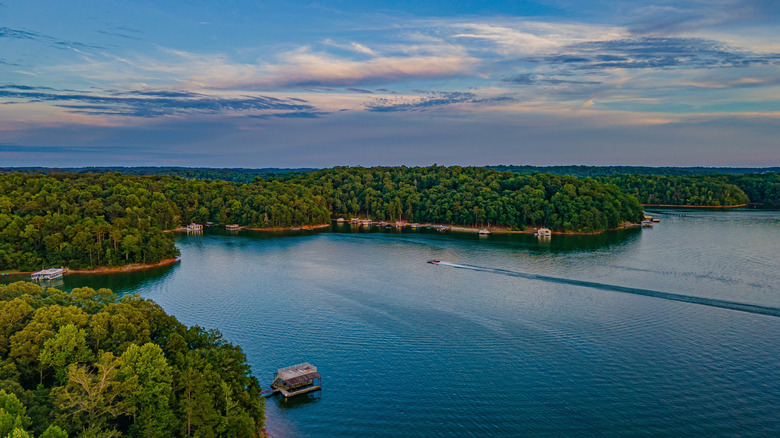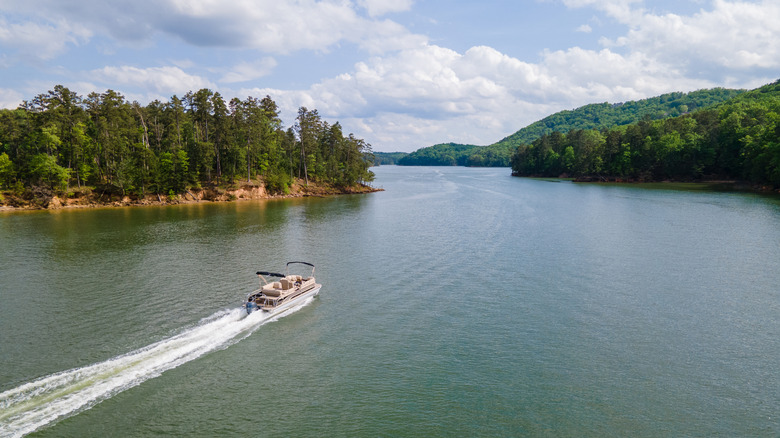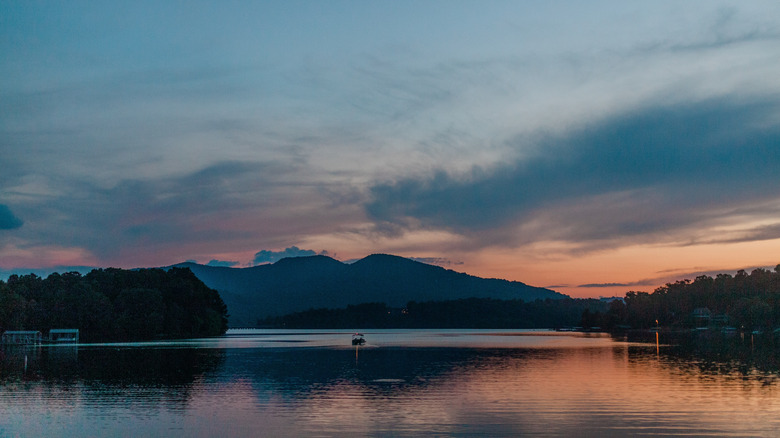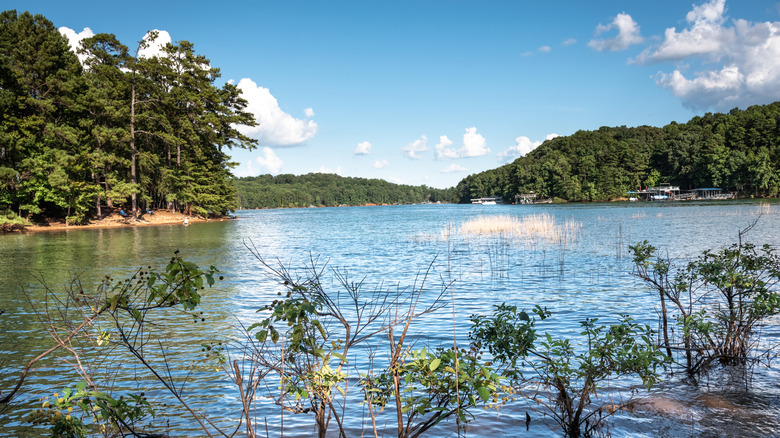The Lake That Many Call The Most Dangerous In America
Located just north of Atlanta, Lake Lanier draws in as many as 12 million visitors a year to its clear waters and scenic shoreline. However, despite its popularity as a recreational destination, the truth is that this Georgia reservoir has actually garnered a pretty troubling reputation. In fact, with more than 700 documented deaths since its creation in 1956, Lake Lanier consistently ranks as one of the deadliest bodies of water in the country. That is saying something considering how many dangerous lakes there are across the U.S.
The lake's deadly statistics speak for themselves. In 2023 alone, 13 people lost their lives at Lake Lanier, a significant jump from the previous year's six drownings. These numbers have prompted many safety experts and locals to continuously warn visitors about the lake's dangers, insisting that you might want to think twice before swimming in Lake Lanier without taking some serious precautions first.
That said, what makes Lake Lanier particularly dangerous isn't just bad luck or coincidence. Instead, the lake's deadly reputation stems from a combination of factors that include everything from heavy boat traffic to submerged hazards, poor visibility, and a dark history that continues to make it a site marked by tragedy.
A deadly pattern of accidents and fatalities
The statistics surrounding Lake Lanier's fatalities paint a grim picture that goes far beyond a handful of isolated incidents. Despite ongoing safety efforts to address the problem, there's actually been little improvement when it comes to injury rates and fatalities. Per the Georgia Department of Natural Resources' statistics, Lake Lanier consistently leads the state in boating incidents, injuries, and boating under the influence violations.
While the causes of these deaths might vary, there are several factors that may point to why they seem to be such a common occurrence. For starters, boating accidents account for a significant portion of fatalities — often due to collisions between vessels, or incidents where passengers fall overboard. This issue is a direct result of the lake's immense popularity, which means that thousands of boats are forced to share the water during peak season, which can create an overcrowded and potentially dangerous environment. Beyond busy waters and congested conditions, alcohol also plays a role in these accidents, with impaired boaters making poor decisions that put everyone's lives at risk.
Finally, drowning incidents also happen with disturbing frequency — even among experienced swimmers. This is primarily due to the lake's deceptive conditions, which fool visitors into underestimating its dangers. So, what initially appears to be a calm, inviting body of water actually harbors hidden threats that can quickly turn a pleasant day into a tragedy.
The tragic history beneath the waters of Lake Lanier
Despite what the name implies, Lake Lanier wasn't always a lake. In reality, the reservoir was actually created after the U.S. Army Corps of Engineers flooded a massive 56,000 acres of land — including the once-thriving town of Oscarville. Originally home to around 250 families, Oscarville was a bustling Black community brimming with activity and prosperity that included churches, schools, and successful businesses in the fertile farmland north of Atlanta.
In the early 1900s, Oscarville quickly became a focal point for Black families looking for new opportunities in north Georgia's agricultural region. However, in 1912, after a series of alleged crimes and racist accusations, violent mobs launched a campaign of terror against the town's Black residents. This included lynchings, church burnings, and threats that eventually forced more than 1,000 Black residents to flee the area permanently.
@joshuadairen Southern Urban Legends #georgia #georgiatiktok #knowgeorgia #lakelanier #lakelaniergeorgia #townunderlakelanier #paranormal #urbanlegend #scarytok #scarystories #series #blackhistory #dairenormal #folklore #acting #actor #travel #traveltiktok #tvshow #travelchannel #tourism #ghost #themoreyouknow #south #hauntedsouth #haunted #hauntedtravel #hauntedtiktok #supernatural #didyouknow #discover #discovery #joshuadairen #georgiatravel
By 1956, as the lake began a slow flooding process that would continue for several years, the community that had once flourished there — including the stories and memories of families who had lost everything to racial violence — was erased from the landscape with callous disregard. Today, what's left of Oscarville still lies beneath Lake Lanier's waters as a submerged reminder of one of Georgia's darkest chapters.
Hidden dangers lurking below the surface
Unlike natural lakes, Lake Lanier contains an entire underwater landscape of roads, building foundations, wells, and even a former race track that make diving, swimming, and boating particularly treacherous. Scattered throughout the lake bed, these submerged obstacles pose serious risks to anyone who ventures below the surface. Divers have reported unexpected encounters with everything from old car parts to the remnants of cemetery structures.
Along with that, visibility in Lake Lanier is also severely limited — it's practically impossible to see anything a mere 20 feet from the shoreline — which means that most people can't even see these underwater hazards until it's too late. Ultimately, this combination of dangerous conditions, murky water, and submerged debris makes diving in Lake Lanier what a local sergeant once referred to as "one of the most dangerous things" they've ever done (via 11Alive). Similarly, the lake's unnatural origins also mean that trees and vegetation were never properly cleared before flooding. As a result, swimmers and boaters can easily become entangled in underwater branches and submerged tree tops that have contributed to accidents over the years, trapping victims who might otherwise have been able to reach safety.
Finally, beyond the physical dangers, many locals believe Lake Lanier carries a spiritual weight from its tragic past. Stories of ghostly encounters have become part of the lake's folklore, with some visitors claiming to see unexplained figures near the water, as well as feeling an unsettling presence that pulls them down and doesn't let go while swimming. And while most skeptics are quick to dismiss these tales as pure superstition, the combination of the lake's deadly history and ongoing fatalities has created a persistent belief among many Georgia residents that Lake Lanier is haunted by displaced souls.
Lake Lanier's enduring appeal continues to this day
Despite its infamous reputation as one of the most dangerous lakes in America, Lake Lanier still remains one of Georgia's most popular destinations. Plus, it's also said to provide essential services to the Atlanta metropolitan area — from supplying drinking water to generating hydroelectric power, and serving a vital role in the region's infrastructure. Additionally, its creation also brought several flood control benefits by protecting downstream communities from the unpredictable Chattahoochee River that once threatened homes and businesses during heavy rains.
From a recreational standpoint, Lake Lanier has around 700 miles of shoreline and covers a whopping 38,000 acres, making it the largest lake in Georgia. Featuring beaches, marinas, campgrounds, and numerous parks dotted around the lake's perimeter, the reservoir is a haven for nature lovers and outdoor enthusiasts looking to get away from the hustle and bustle and enjoy a more laid-back atmosphere.
So, while safety concerns persist — and a dark history continues to cast a somber shadow over the area — plenty of local and visiting families still flock to Lake Lanier for a dose of recreation and relaxation. And, if you're hoping to be one of them, just remember to take proper precautions to avoid any accidents. This includes always following the proper safety protocols, paying attention to posted warning signs and designated swimming areas, wearing a life jacket, and keeping your eyes open for fresh water dangers hiding in plain sight.




